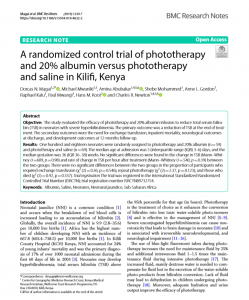
Objective
The study evaluated the efficacy of phototherapy and 20% albumin infusion to reduce total serum bilirubin (TSB) in neonates with severe hyperbilirubinemia. The primary outcome was a reduction of TSB at the end of treatment. The secondary outcomes were the need for exchange transfusion, inpatient mortality, neurological outcomes at discharge, and development outcomes at 12-months follow-up.
Results
One hundred and eighteen neonates were randomly assigned to phototherapy and 20% albumin (n = 59) and phototherapy and saline (n = 69). The median age at admission was 5 (interquartile range (IQR) 3–6) days, and the median gestation was 36 (IQR 36–38) weeks. No significant differences were found in the change in TSB (Mann–Whitney U =609, p = 0.98) and rate of change in TSB per hour after treatment (Mann–Whitney U = 540, p = 0.39) between the two groups. There were no significant differences between the two groups in the proportion of participants who required exchange transfusion (χ2 (2) = 0.36, p = 0.546); repeat phototherapy (χ2 (2) = 2.37, p = 0.123); and those who died (χ2 (2) = 0.92, p = 0.337).